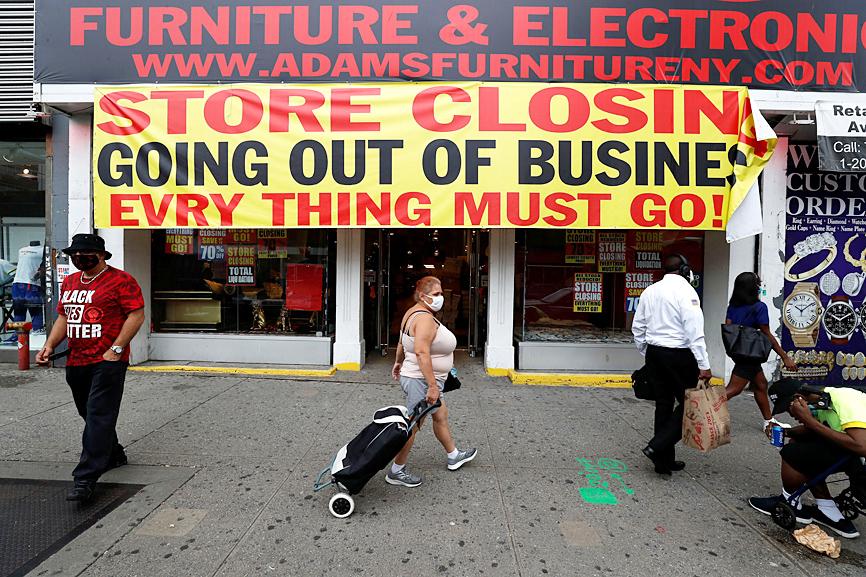The US stock market has been on a tear, yet the country’s economy is in the dumps. So why do so many people believe — undoubtedly incorrectly — that the stock market has decoupled from reality?
The economy many people experience, while bleak, is local, personal and, for the most part, either not publicly traded or plays only a small part in the stock market’s moves. To explain why these personal experiences have so little effect on equity markets, we must look more closely at the market role of the weakest industry sectors.
The surprising conclusion: The most visible and economically vulnerable industries are also among the smallest, based on their market-capitalization weight in major indices such as the S&P 500. Markets, it turns out, are not especially vulnerable to highly visible, but relatively tiny industries.

Photo: Reuters
The 30 most economically damaged industry categories could be delisted before tomorrow’s market open, and it would hardly shave more than a few percentage points off the S&P 500.
This is so despite the worst US economic collapse since the Great Depression. All of the economic data are so bad that figures on GDP, unemployment and initial jobless claims must be re-scaled to even fit on charts.
However, the US economy is not the stock market and vice versa. Ignoring overseas strength is a major oversight. The so-called FAANG — Facebook Inc, Apple Inc, Amazon.com Inc, Netflix Inc and Google parent Alphabet Inc — along with Microsoft Corp, derive about half — and in some cases even more — of their revenue from abroad.
Beyond that, the COVID-19 pandemic lockdown in the US has benefited the giant tech companies’ sales and profits. No wonder the NASDAQ Composite 100 Index, which is dominated by big tech companies, is up about 26 percent this year.
However, a reasonable person might argue that GDP fell by about one-third in the second quarter and the S&P 500 should be in synch with that.
What is more, of the 500 companies in the S&P 500, about 450 of them are doing terribly. Industries such as retail, travel, energy, entertainment and dining have seen sales evaporate.
Bankruptcies are piling up — legendary retailer Lord & Taylor is just the latest — and more are surely coming. Yet, the S&P 500, after a huge plunge in March, is up 2 percent this year.
Market capitalization explains why.
Start with some of this year’s worst-performing industries: As of the end of last month, these include department stores, down 62.6 percent; airlines, off 55 percent; travel services, down 51.4 percent; oil and gas equipment and services, down 50.5 percent; resorts and casinos, down 45.4 percent; and hotel and motel real-estate investment trusts, off 41.9 percent. The next 15 industry sectors in the index are down between 30.5 percent and 41.7 percent. That is four months after the market rebounded from the lows of late March.
These are highly visible industries, with companies that are well-covered by the news media with household names known to many consumers. Retailers are everywhere we go. Gas stations, chain restaurants and hotels are ubiquitous in cities and suburbs across the country.
So although high visibility industries might be of considerable significance to the economy, they are not very significant to the capitalization-weighted stock market indices.
Consider how little these beaten-up sectors mentioned above affect the indices. Department stores might have fallen 62.3 percent, but on a market-cap basis they are a mere 0.01 percent of the S&P 500. Airlines are larger, but not much: They weigh in at 0.18 percent of the index. The story is the same for travel services, hotel and motel real-estate investment trusts, and resorts and casinos.
The market is telling us that these industries just do not matter very much to stock market performance.
And the sectors that do matter? Consider that just four industry groups — Internet content, software infrastructure, consumer electronics and Internet retailers — account for more than US$8 trillion in market value, or almost one-quarter of total US stock market value of about US$35 trillion.
Take the 10 biggest technology companies in the S&P 500 and weight them equally, and they would be up more than 37 percent for the year. Do the same for the next 490 names in the index, and they are down about 7.7 percent. That shows just how much a few giant matter to the index.
On some level, it is completely understandable why many people believe that markets are no longer tethered to reality, because the performance does not correspond to their personal experience, which is one of job loss, economic hardship and personal despair.
However, what is important to understand is that indices based on market-cap weighting can be — as they are now — driven by the gains of just a handful of companies.
We can argue about whether the way the market reacts is good or bad and never reach a satisfying conclusion.
However, one thing the market is not is irrational or disconnected from is the reality of market capitalization, and its impact on stock indices.
Barry Ritholtz is a Bloomberg Opinion columnist. He is chairman and chief investment officer of Ritholtz Wealth Management and was previously chief market strategist at Maxim Group. He is the author of Bailout Nation.
This column does not necessarily reflect the opinion of the editorial board or Bloomberg LP and its owners.

The DBS Foundation yesterday announced the launch of two flagship programs, “Silver Motion” and “Happier Caregiver, Healthier Seniors,” in partnership with CCILU Ltd, Hondao Senior Citizens’ Welfare Foundation and the Garden of Hope Foundation to help Taiwan face the challenges of a rapidly aging population. The foundation said it would invest S$4.91 million (US$3.8 million) over three years to foster inclusion and resilience in an aging society. “Aging may bring challenges, but it also brings opportunities. With many Asian markets rapidly becoming super-aged, the DBS Foundation is working with a regional ecosystem of like-minded partners across the private, public and people sectors

BREAKTHROUGH TECH: Powertech expects its fan-out PLP system to become mainstream, saying it can offer three-times greater production throughput Chip packaging service provider Powertech Technology Inc (力成科技) plans to more than double its capital expenditures next year to more than NT$40 billion (US$1.31 billion) as demand for its new panel-level packaging (PLP) technology, primarily used in chips for artificial intelligence (AI) applications, has greatly exceeded what it can supply. A significant portion of the budget, about US$1 billion, would be earmarked for fan-out PLP technology, Powertech told investors yesterday. Its heavy investment in fan-out PLP technology over the past 10 years is expected to bear fruit in 2027 after the technology enters volume production, it said, adding that the tech would

YEAR-END BOOST: The holiday shopping season in the US and Europe, combined with rising demand for AI applications, is expected to drive exports to a new high, the NDC said Taiwan’s business climate monitor improved last month, transitioning from steady growth for the first time in five months, as robust global demand for artificial intelligence (AI) products and new iPhone shipments boosted exports and corporate sales, the National Development Council (NDC) said yesterday. The council uses a five-color system to measure the nation’s economic state, with “green” indicating steady growth, “red” suggesting a boom and “blue” reflecting a recession. “Yellow-red” and “yellow-blue” suggest a transition to a stronger or weaker condition. The total score of the monitor’s composite index rose to 35 points from a revised 31 in August, ending a four-month

RUN IT BACK: A succesful first project working with hyperscalers to design chips encouraged MediaTek to start a second project, aiming to hit stride in 2028 MediaTek Inc (聯發科), the world’s biggest smartphone chip supplier, yesterday said it is engaging a second hyperscaler to help design artificial intelligence (AI) accelerators used in data centers following a similar project expected to generate revenue streams soon. The first AI accelerator project is to bring in US$1 billion revenue next year and several billion US dollars more in 2027, MediaTek chief executive officer Rick Tsai (蔡力行) told a virtual investor conference yesterday. The second AI accelerator project is expected to contribute to revenue beginning in 2028, Tsai said. MediaTek yesterday raised its revenue forecast for the global AI accelerator used